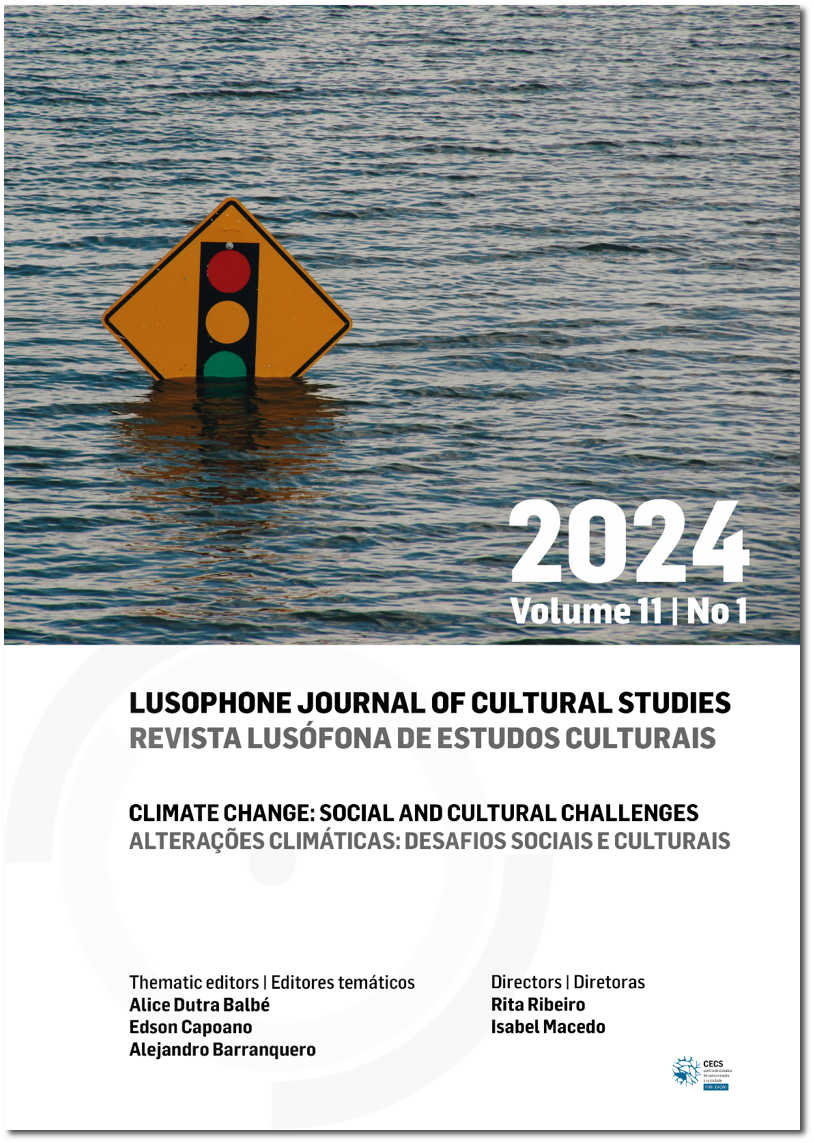Activist Art and Ecological Art: Exploring the Interplay of Culture, Environment, and Society, Artistic Approaches, and Cultural Production Contexts
DOI:
https://doi.org/10.21814/rlec.5477Keywords:
ecological art, environmental art activism, culture and environment, political identity of art, cultural productionAbstract
Environmental activism, expressed through art, prompts an educational process, generating reflections and evoking a sense of vulnerability experienced by human bodies before the reality of the climate emergency (Rodriguez-Labajos, 2022). Because ecological art sparks subjective responses aimed at raising awareness and driving action on socio-environmental concerns, this theoretical, reflective, and interpretive article seeks to explore the concepts of “activist art”, “ecological art”, and analogous designations in order to analyse the interplay between culture, environment, and society and the conditions shaping cultural production practices. In pursuit of this objective, our inquiry delved into the framework of Félix Guattari’s concept of “eco-art” (1989/1990), the nature of ecological art approaches and the primary environmental causes they address, the contextual landscape in which environmental activist art practices unfolds and the dynamics of cultural production. Examples from Portuguese artists and projects were used to elucidate the nuances of creative practices and strategies linked to environmental sustainability, aspects relating to environmental education, ethical issues and cultural policies that align with ecological art. This article aims to contribute to the discussion on ecological art by exploring the political identity of art and emphasising the indispensable and inherent analysis between cultural practices and the environment.
Downloads
References
Bordowitz, G. (2004). Tactics inside and out: Critical art ensemble. ArtForum, 43(1), 212–215. https://www.artforum.com/features/tactics-inside-and-out-critical-art-ensemble-169387/
Brunner, C., Nigro, R., & Raunig, G. (2013). Post-media activism, social ecology and eco-art. Third Text, 27(1), 10–16. https://doi.org/10.1080/09528822.2013.752200
Cevasco, M. E. (2003). Dez lições sobre estudos culturais. Boitempo Editorial.
DGARTES. (2022, 28 de abril). DGARTES apoia dezoito projetos que cruzam arte com ambiente. https://www.dgartes.gov.pt/pt/node/5165
Ecoart Network. (2023). About the community. https://www.ecoartnetwork.org/about
Exposição de Bordalo II alerta para os perigos da destruição do planeta. (2019, 25 de janeiro). euronews. https://pt.euronews.com/2019/01/25/exposicao-de-bordalo-ii-alerta-para-os-perigos-da-destruicao-do-planeta
Freitas, M. (2008). Natureza, cultura, ambiente e desenvolvimento: Um ensaio sobre a viabilidade de uma cultura (comum) da sustentabilidade. In T. G. Parente & H. G. D. Magalhães (Eds.), Linguagens plurais: Cultura e meio ambiente (pp. 13–40). EDUSC.
Gablik, S. (1992). The ecological imperative. Art Journal, 51(2), 49–51.
Gorz, A. (2011). Ecológica. Clave Intelectual.
Guattari, F. (1990). As três ecologias (21.ª ed., M. C. F. Bittencourt, Trad.). Papirus. (Trabalho original publicado em 1989)
Hall, S. (1980). Cultural studies: Two paradigms. Media, Culture and Society, 2, 57–72. https://doi.org/https://doi.org/10.1177/016344378000200106
Hall, S. (1992). Cultural studies and its theoretical legacies. In L. Grossberg, C. Nelson, & P. Treichler (Eds.), Cultural studies (pp. 277–294). Routledge.
Jacobi, P. (2003). Educação ambiental, cidadania e sustentabilidade. Cadernos de Pesquisa, (118), 189–205. https://doi.org/10.1590/s0100-15742003000100008
Kagan, S. (2014). The practice of ecological art. [plastik], (4). https://plastik.univ-paris1.fr/2014/02/15/la-pratique-de-lart-ecologique
Krieg-Planque, A. (2010). La formule “développement durable” : Un opérateur de neutralisation de la conflictualité. Langage et Société, (4), 5–29. https://doi.org/10.3917/ls.134.0005
Lopes, A. C., Farinha, J., & Amado, M. (2017). Sustainability through art. Energy Procedia, 119, 752–766. https://doi.org/10.1016/j.egypro.2017.07.102
Menezes, S. M. P. de. (2018). Distopia ou utopia: Cultura, criatividade e território. [Tese de doutoramento, Universidade de Aveiro]. ria. http://hdl.handle.net/10773/25042
Nações Unidas. (2023, 16 de setembro). A ONU e o meio ambiente. https://brasil.un.org/pt-br/91223-onu-e-o-meio-ambiente
Nascimento, E. P. d. (2012). Trajetória da sustentabilidade: Do ambiental ao social, do social ao econômico. Estudos Avançados, 26(74), 51–64. https://doi.org/10.1590/S0103-40142012000100005
Peixeiro, F. (2024, 10 de fevereiro). As aves da Lezíria que impediram o aeroporto no Montijo. Diário de Notícias. https://www.dn.pt/5056964033/as-aves-da-leziria-que-impediram-o-aeroporto-no-montijo/
Polli, A. (2012). Soundscape, sonification, and sound activism. AI & SOCIETY, 27(2), 257–268. https://doi.org/10.1007/s00146-011-0345-3
Prado, L. C. D., & Barradas, A. V. (2023). Economia do cinema e do audiovisual: Teorias e concorrência. Textos Para Discussão — Instituto de Economia.
Rancière, J. (2007). Será que a arte resiste a alguma coisa? (M. C. Netto, Trad.). Riseup. https://we.riseup.net/assets/404237/Jacques+Ranci%C3%A8re+Sera+que+a+arte+resiste+a+alguma+coisa.pdf
Rodriguez-Labajos, B. (2022). Artistic activism promotes three major forms of sustainability transformation. Current Opinion in Environmental Sustainability, 57, 1–8. https://doi.org/10.1016/j.cosust.2022.101199
Ribeiro, A. M. (2017, 26–29 de julho). Raymond Williams e Stuart Hall: Perspectivas, objetos e engajamento [Apresentação de comunicação]. 18.º Congresso Brasileiro de Sociologia: Que sociologias fazemos? Interfaces com contextos local, nacional e global, Brasília, Brasil.
Ribeiro, A. S. d. C. A. e., & Almeida, T. (2021). Ecossemântica do mundo arte. Revista ARA, 11(11), 249–264. https://doi.org/10.11606/issn.2525-8354.v11i11p249-264
Sanz, T., & Rodriguez-Labajos, B. (2021). Does artistic activism change anything? Strategic and transformative effects of arts in anti-coal struggles in Oakland, CA. Geoforum, 122, 41–54. https://doi.org/https://doi.org/10.1016/j.geoforum.2021.03.010
Sheikh, S. (2017, 17 de julho). Positively Trojan horses revisited. Void Network. https://voidnetwork.gr/2017/07/13/14889/
Vasko, Z. (2016). Connections between artistic practice and experiences in nature: Considerations for how art education can engender ecological awareness. Canadian Review of Art Education, 42(2), 69–79. https://doi.org/10.26443/crae.v42i2.8
Vieira, T. (2007). Artivismo: Estratégias artísticas contemporâneas de resistência cultural [Dissertação de mestrado, Universidade do Porto]. Repositório Aberto. http://hdl.handle.net/10216/7307
Wallen, R. (2012). Ecological art: A call for visionary intervention in a time of crisis. Leonardo, 45(3), 234–242. https://doi.org/10.1162/LEON_a_00365
Walsh, C. (2012). The politics of naming: (Inter)cultural studies in de-colonial code. Cultural Studies, 26(1), 108–125. https://doi.org/10.1080/09502386.2012.642598
Williams, R. (1961). The long revolution. Chatto & Windus.
Williams, R. (1998). The analysis of culture. In J. Storey (Ed.), Cultural theory and popular culture: A reader (pp. 48–56). The University of Georgia Press.
Downloads
Published
How to Cite
Issue
Section
License
Copyright (c) 2024 Tatiana Lopes Vargas

This work is licensed under a Creative Commons Attribution 4.0 International License.
Authors own the copyright, providing the journal with the right of first publication. The work is licensed under a Creative Commons - Atribuição 4.0 Internacional License.












